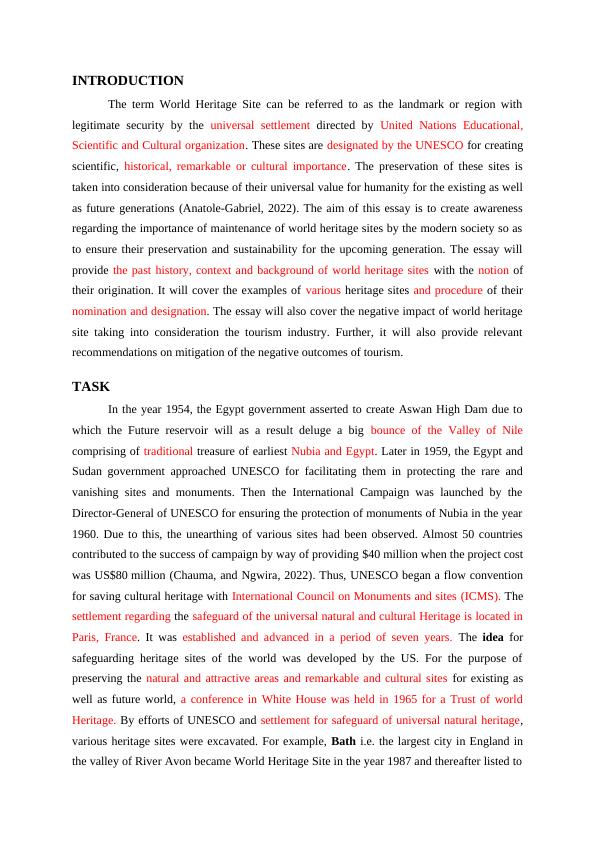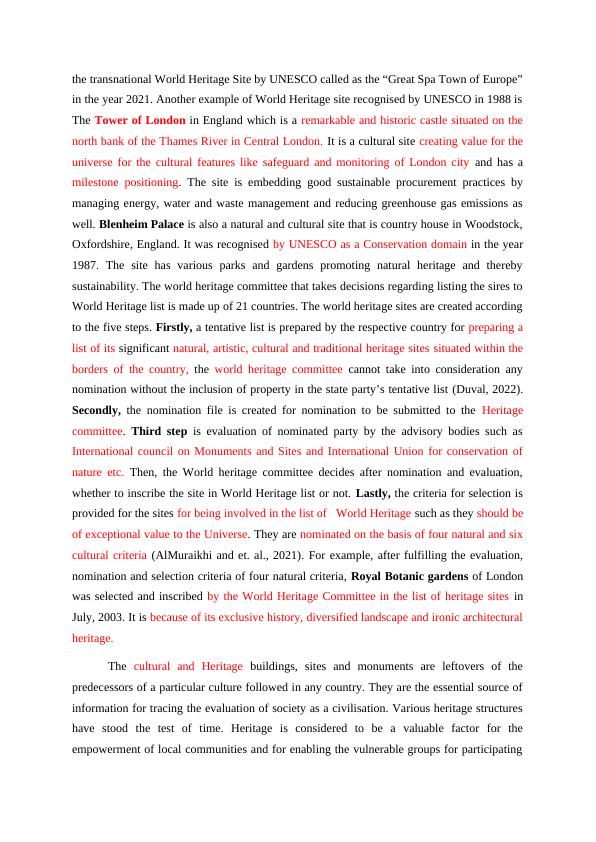Importance of Maintaining World Heritage Sites for Sustainability
Added on 2023-06-08
6 Pages2073 Words205 Views
Academic Writing for
Business
and Management
Business
and Management

INTRODUCTION
The term World Heritage Site can be referred to as the landmark or region with
legitimate security by the universal settlement directed by United Nations Educational,
Scientific and Cultural organization. These sites are designated by the UNESCO for creating
scientific, historical, remarkable or cultural importance. The preservation of these sites is
taken into consideration because of their universal value for humanity for the existing as well
as future generations (Anatole-Gabriel, 2022). The aim of this essay is to create awareness
regarding the importance of maintenance of world heritage sites by the modern society so as
to ensure their preservation and sustainability for the upcoming generation. The essay will
provide the past history, context and background of world heritage sites with the notion of
their origination. It will cover the examples of various heritage sites and procedure of their
nomination and designation. The essay will also cover the negative impact of world heritage
site taking into consideration the tourism industry. Further, it will also provide relevant
recommendations on mitigation of the negative outcomes of tourism.
TASK
In the year 1954, the Egypt government asserted to create Aswan High Dam due to
which the Future reservoir will as a result deluge a big bounce of the Valley of Nile
comprising of traditional treasure of earliest Nubia and Egypt. Later in 1959, the Egypt and
Sudan government approached UNESCO for facilitating them in protecting the rare and
vanishing sites and monuments. Then the International Campaign was launched by the
Director-General of UNESCO for ensuring the protection of monuments of Nubia in the year
1960. Due to this, the unearthing of various sites had been observed. Almost 50 countries
contributed to the success of campaign by way of providing $40 million when the project cost
was US$80 million (Chauma, and Ngwira, 2022). Thus, UNESCO began a flow convention
for saving cultural heritage with International Council on Monuments and sites (ICMS). The
settlement regarding the safeguard of the universal natural and cultural Heritage is located in
Paris, France. It was established and advanced in a period of seven years. The idea for
safeguarding heritage sites of the world was developed by the US. For the purpose of
preserving the natural and attractive areas and remarkable and cultural sites for existing as
well as future world, a conference in White House was held in 1965 for a Trust of world
Heritage. By efforts of UNESCO and settlement for safeguard of universal natural heritage,
various heritage sites were excavated. For example, Bath i.e. the largest city in England in
the valley of River Avon became World Heritage Site in the year 1987 and thereafter listed to
The term World Heritage Site can be referred to as the landmark or region with
legitimate security by the universal settlement directed by United Nations Educational,
Scientific and Cultural organization. These sites are designated by the UNESCO for creating
scientific, historical, remarkable or cultural importance. The preservation of these sites is
taken into consideration because of their universal value for humanity for the existing as well
as future generations (Anatole-Gabriel, 2022). The aim of this essay is to create awareness
regarding the importance of maintenance of world heritage sites by the modern society so as
to ensure their preservation and sustainability for the upcoming generation. The essay will
provide the past history, context and background of world heritage sites with the notion of
their origination. It will cover the examples of various heritage sites and procedure of their
nomination and designation. The essay will also cover the negative impact of world heritage
site taking into consideration the tourism industry. Further, it will also provide relevant
recommendations on mitigation of the negative outcomes of tourism.
TASK
In the year 1954, the Egypt government asserted to create Aswan High Dam due to
which the Future reservoir will as a result deluge a big bounce of the Valley of Nile
comprising of traditional treasure of earliest Nubia and Egypt. Later in 1959, the Egypt and
Sudan government approached UNESCO for facilitating them in protecting the rare and
vanishing sites and monuments. Then the International Campaign was launched by the
Director-General of UNESCO for ensuring the protection of monuments of Nubia in the year
1960. Due to this, the unearthing of various sites had been observed. Almost 50 countries
contributed to the success of campaign by way of providing $40 million when the project cost
was US$80 million (Chauma, and Ngwira, 2022). Thus, UNESCO began a flow convention
for saving cultural heritage with International Council on Monuments and sites (ICMS). The
settlement regarding the safeguard of the universal natural and cultural Heritage is located in
Paris, France. It was established and advanced in a period of seven years. The idea for
safeguarding heritage sites of the world was developed by the US. For the purpose of
preserving the natural and attractive areas and remarkable and cultural sites for existing as
well as future world, a conference in White House was held in 1965 for a Trust of world
Heritage. By efforts of UNESCO and settlement for safeguard of universal natural heritage,
various heritage sites were excavated. For example, Bath i.e. the largest city in England in
the valley of River Avon became World Heritage Site in the year 1987 and thereafter listed to

the transnational World Heritage Site by UNESCO called as the “Great Spa Town of Europe”
in the year 2021. Another example of World Heritage site recognised by UNESCO in 1988 is
The Tower of London in England which is a remarkable and historic castle situated on the
north bank of the Thames River in Central London. It is a cultural site creating value for the
universe for the cultural features like safeguard and monitoring of London city and has a
milestone positioning. The site is embedding good sustainable procurement practices by
managing energy, water and waste management and reducing greenhouse gas emissions as
well. Blenheim Palace is also a natural and cultural site that is country house in Woodstock,
Oxfordshire, England. It was recognised by UNESCO as a Conservation domain in the year
1987. The site has various parks and gardens promoting natural heritage and thereby
sustainability. The world heritage committee that takes decisions regarding listing the sires to
World Heritage list is made up of 21 countries. The world heritage sites are created according
to the five steps. Firstly, a tentative list is prepared by the respective country for preparing a
list of its significant natural, artistic, cultural and traditional heritage sites situated within the
borders of the country, the world heritage committee cannot take into consideration any
nomination without the inclusion of property in the state party’s tentative list (Duval, 2022).
Secondly, the nomination file is created for nomination to be submitted to the Heritage
committee. Third step is evaluation of nominated party by the advisory bodies such as
International council on Monuments and Sites and International Union for conservation of
nature etc. Then, the World heritage committee decides after nomination and evaluation,
whether to inscribe the site in World Heritage list or not. Lastly, the criteria for selection is
provided for the sites for being involved in the list of World Heritage such as they should be
of exceptional value to the Universe. They are nominated on the basis of four natural and six
cultural criteria (AlMuraikhi and et. al., 2021). For example, after fulfilling the evaluation,
nomination and selection criteria of four natural criteria, Royal Botanic gardens of London
was selected and inscribed by the World Heritage Committee in the list of heritage sites in
July, 2003. It is because of its exclusive history, diversified landscape and ironic architectural
heritage.
The cultural and Heritage buildings, sites and monuments are leftovers of the
predecessors of a particular culture followed in any country. They are the essential source of
information for tracing the evaluation of society as a civilisation. Various heritage structures
have stood the test of time. Heritage is considered to be a valuable factor for the
empowerment of local communities and for enabling the vulnerable groups for participating
in the year 2021. Another example of World Heritage site recognised by UNESCO in 1988 is
The Tower of London in England which is a remarkable and historic castle situated on the
north bank of the Thames River in Central London. It is a cultural site creating value for the
universe for the cultural features like safeguard and monitoring of London city and has a
milestone positioning. The site is embedding good sustainable procurement practices by
managing energy, water and waste management and reducing greenhouse gas emissions as
well. Blenheim Palace is also a natural and cultural site that is country house in Woodstock,
Oxfordshire, England. It was recognised by UNESCO as a Conservation domain in the year
1987. The site has various parks and gardens promoting natural heritage and thereby
sustainability. The world heritage committee that takes decisions regarding listing the sires to
World Heritage list is made up of 21 countries. The world heritage sites are created according
to the five steps. Firstly, a tentative list is prepared by the respective country for preparing a
list of its significant natural, artistic, cultural and traditional heritage sites situated within the
borders of the country, the world heritage committee cannot take into consideration any
nomination without the inclusion of property in the state party’s tentative list (Duval, 2022).
Secondly, the nomination file is created for nomination to be submitted to the Heritage
committee. Third step is evaluation of nominated party by the advisory bodies such as
International council on Monuments and Sites and International Union for conservation of
nature etc. Then, the World heritage committee decides after nomination and evaluation,
whether to inscribe the site in World Heritage list or not. Lastly, the criteria for selection is
provided for the sites for being involved in the list of World Heritage such as they should be
of exceptional value to the Universe. They are nominated on the basis of four natural and six
cultural criteria (AlMuraikhi and et. al., 2021). For example, after fulfilling the evaluation,
nomination and selection criteria of four natural criteria, Royal Botanic gardens of London
was selected and inscribed by the World Heritage Committee in the list of heritage sites in
July, 2003. It is because of its exclusive history, diversified landscape and ironic architectural
heritage.
The cultural and Heritage buildings, sites and monuments are leftovers of the
predecessors of a particular culture followed in any country. They are the essential source of
information for tracing the evaluation of society as a civilisation. Various heritage structures
have stood the test of time. Heritage is considered to be a valuable factor for the
empowerment of local communities and for enabling the vulnerable groups for participating

End of preview
Want to access all the pages? Upload your documents or become a member.
Related Documents
World Heritage Sites: History, Importance, and Adverse Impacts on Tourism Industrylg...
|7
|2059
|105
World Heritage Sites: History, Importance, and Adverse Impacts on Tourism Industrylg...
|7
|2070
|106
Importance of World Heritage Sites in Modern Societylg...
|8
|1939
|386
Importance of Maintaining World Heritage Sites for Modern Societylg...
|7
|1961
|491
Importance of Maintaining World Heritage Sites for Modern Societylg...
|7
|2017
|94
World Heritage Sites: Importance, Nomination Process, and Recommendations for Preservationlg...
|7
|1830
|261
